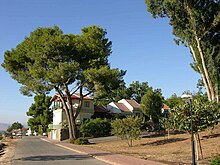Shamir, Israel
Shamir | |
|---|---|
 | |
| Coordinates: 33°9′55″N 35°39′39″E / 33.16528°N 35.66083°E | |
| Country | Israel |
| District | Northern |
| Council | Upper Galilee |
| Affiliation | Kibbutz Movement |
| Founded | 1944 |
| Founded by | Romanian Hashomer Hatzair members |
| Population (2022)[1] | 921 |
| Website | www.shamir.org.il |


Shamir (Hebrew: שָׁמִיר) is a kibbutz in Upper Galilee area of Israel. Located on the western slopes of the Golan Heights, it falls under the jurisdiction of Upper Galilee Regional Council. In 2022 it had a population of 921.[1]
History


The kibbutz was established in 1944 by a small group of mainly Romanian immigrants. The first-generation settlers were members of the Marxist Zionist youth movement Hashomer Hatzair. Following the 1948 Arab–Israeli War the United Nations-established border between Israel and Syria was drawn to run only a few hundred yards east of the kibbutz.
On Thursday 13 June 1974, four PFLP-GC[2][3] terrorists infiltrated the Lebanon-Israel border and invaded the kibbutz.[4] They entered one of the buildings shooting a pregnant woman Edna Mor (28) and another woman Shoshana Galili (58). Edna left behind a child and husband. The terrorists continued shooting at random. Judith Sinton (19),[5] a Kibbutz volunteer from New Zealand, on her way back to the apiary after breakfast, was shot and killed by one of the terrorists. The members of the kibbutz seized their weapons and ran in the direction from where gunfire was heard. In the gun battle that followed, all four terrorists were killed. The terrorists' aim was to take hostages to exchange for jailed terrorists. Their written message ends: "We love to die, as you love to live."[6] The artist Avraham Eilat who was at that time a member of the kibbutz documented the event.
Economy
As of 2006, Shamir was one of the most prosperous kibbutzim in Israel, producing honey, toiletries, and advanced optical products. The optical enterprise, Shamir Optical Industry, was previously a fully incorporated stock company, quoted on NASDAQ. In 2011 Essilor became a 50% shareholder and the company went private.[citation needed]
The kibbutz also earns money from tourism; it offers views of Mount Hermon to the north and the Hula Valley below the kibbutz. A relatively rare phenomenon can be observed from Shamir—a "sunrise in the west." As the kibbutz is nested in the steeply-rising western slopes of the Golan, when the sun rises, its first rays at daybreak illuminate the peaks of the Ramim mountain range across the valley to the west of Shamir. As the sun climbs progressively higher, more of Ramim is bathed in sunshine, which can then be observed progressing from west to east, down the slopes of Ramim, across the valley and up the slopes of the Golan before reaching the kibbutz.[citation needed]
Landmarks
Of notable interest are some 3rd-century border stones with Greek inscriptions.[7] Surrounding the kibbutz is a field of more than 400 dolmens, dated to the Bronze Age IB (c. 2350–2000 BCE). The largest of the dolmens has a basalt capstone of 50 tons which has rock art on its underside—the only art known from dolmens in the southern Levant. Its excavators judge that the scale of the dolmen field and size of the dolmens indicate a governmental system more complex than that usually assigned to the period.[8]
Notable people
References
- ^ a b "Regional Statistics". Israel Central Bureau of Statistics. Retrieved 21 March 2024.
- ^ "Middle East: Cease-Fire Strains". Time Magazine. June 24, 1974. Retrieved 26 October 2024.
- ^ "Armed Struggle and the Search for State", Y. Sayigh, p.341
- ^ "Guerrilla strike a warning to Nixon". Sydney Morning Herald. 15 June 1974. Retrieved 23 June 2018.
- ^ "She made the supreme sacrifice" The Times (NZ), 26 June 1974
- ^ CBS evening news Jun 13, 1974 Vanderbilt Television News Archive
- ^ Aharoni, "Three New Boundary Stones from the Western Golan," Pl. IX No. 2.
- ^ Gonen Sharon; Alon Barash; Davida Eisenberg-Degen; Leore Grosman; Maya Oron; Uri Berger (2017). "Monumental megalithic burial and rock art tell a new story about the Levant Intermediate Bronze "Dark Ages"". PLOS ONE. 12 (3): e0172969. Bibcode:2017PLoSO..1272969S. doi:10.1371/journal.pone.0172969. PMC 5333866. PMID 28253312.
External links
- Official website (in Hebrew)

